
Yahweh was an ancient Levantine deity, and national god of the Israelite kingdoms of Israel and Judah. Though no consensus exists regarding the deity's origins, scholars generally contend that Yahweh is associated with Seir, Edom, Paran and Teman, and later with Canaan. The origins of his worship reach at least to the early Iron Age, and likely to the Late Bronze Age, if not somewhat earlier.

ʼĒl is a Northwest Semitic word meaning 'god' or 'deity', or referring to any one of multiple major ancient Near Eastern deities. A rarer form, 'ila, represents the predicate form in the Old Akkadian and Amorite languages. The word is derived from the Proto-Semitic *ʔil-, meaning "god".

Qetesh was a goddess who was incorporated into the ancient Egyptian religion in the late Bronze Age. Her name was likely developed by the Egyptians based on the Semitic root Q-D-Š meaning 'holy' or 'blessed,' attested as a title of El and possibly Athirat and a further independent deity in texts from Ugarit.
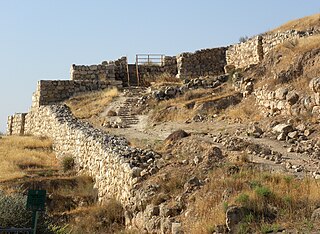
Lachish was an ancient Canaanite and Israelite city in the Shephelah region of Israel, on the south bank of the Lakhish River, mentioned several times in the Hebrew Bible. The current tell (ruin) by that name, known as Tel Lachish or Tell ed-Duweir, has been identified with the biblical Lachish. Today, it is an Israeli national park operated and maintained by the Israel Nature and Parks Authority. It lies near the present-day moshav of Lakhish.

Asherah is the great goddess in ancient Semitic religion. She also appears in Hittite writings as Ašerdu(s) or Ašertu(s). Her name was Aṯeratum to the Amorites, and Athiratu in Ugarit. Many scholars hold that Yahweh and Asherah were a consort pair in ancient Israel and Judah, although others disagree.

An Asherah pole is a sacred tree or pole that stood near Canaanite religious locations to honor the goddess Asherah. The relation of the literary references to an asherah and archaeological finds of Judaean pillar-figurines has engendered a literature of debate.

The Canaanite religion was the group of ancient Semitic religions practiced by the Canaanites living in the ancient Levant from at least the early Bronze Age to the first centuries CE. Canaanite religion was polytheistic and, in some cases, monolatristic.
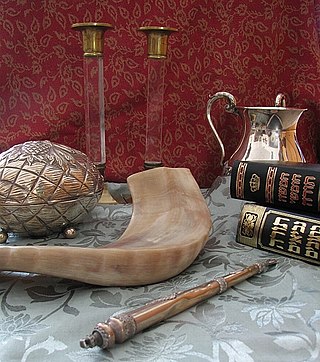
The origins of Judaism lie in Bronze Age polytheistic Canaanite religion. Judaism also syncretized elements of other Semitic religions such as Babylonian religion, which is reflected in the early prophetic books of the Hebrew Bible.

Q-D-Š is a triconsonantal Semitic root meaning "sacred, holy", derived from a concept central to ancient Semitic religion. From a basic verbal meaning "to consecrate, to purify", it could be used as an adjective meaning "holy", or as a substantive referring to a "sanctuary, sacred object, sacred personnel."

The ivory pomegranate or Jerusalem Pomegranate is a thumb-sized ornamental artifact acquired by the Israel Museum. It is not actually made of ivory, but of hippopotamus bone and bears an inscription; Holy (Sacred) to the Priest of the House of God (YHWH).
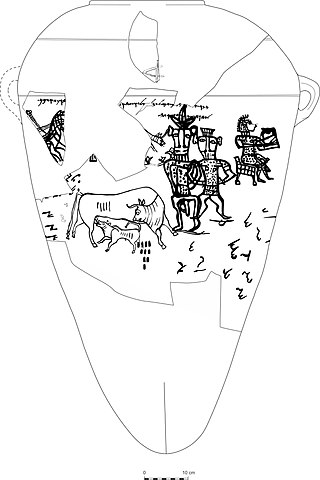
Kuntillet Ajrud or Horvat Teman is a late 9th/early 8th centuries BCE site in the northeast part of the Sinai Peninsula. It is frequently described as a shrine, though this is not certain. The Kuntillet Ajrud inscriptions discovered in the excavations are significant in biblical archaeology.
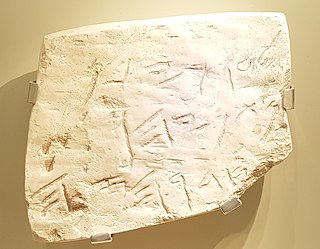
Khirbet el-Qom is an archaeological site in the village of al-Kum, West Bank, in the territory of the biblical Kingdom of Judah, between Lachish and Hebron, 14 km (8.7 mi) to the west of the latter.
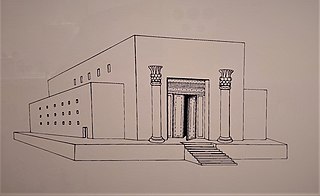
Solomon's Temple, also known as the First Temple, was a biblical Temple in Jerusalem believed to have existed between the 10th and 6th centuries BCE. Its description is largely based on narratives in the Hebrew Bible, in which it was commissioned by biblical king Solomon before being destroyed during the Siege of Jerusalem by Nebuchadnezzar II of the Neo-Babylonian Empire in 587 BCE. Although no remains of the temple have ever been found, most modern scholars agree that the First Temple existed on the Temple Mount in Jerusalem by the time of the Babylonian siege, though there is significant debate over the date of its construction and the identity of its builder.

The Kenite hypothesis proposes that the origins of Yahweh, and by extension Yahwism, do not lie in Canaan, but instead originated in the area immediately south of the Levant, the northwest Arabian Peninsula, on the east shore of the Gulf of Aqaba on the Red Sea, in the area the Tanakh calls "Midian". The theory states that Yahweh originally was a Midianite deity, who made his way up north to the proto-Israelites.
A ceremonial pole is a stake or post utilised or venerated as part of a ceremony or religious ritual. Ceremonial poles may symbolize a variety of concepts in different ceremonies and rituals practiced by a variety of cultures around the world.

Yahwism, as it is called by modern scholars, was the religion of ancient Israel and Judah. An ancient Semitic religion of the Iron Age, Yahwism was essentially polytheistic and had a pantheon, with various gods and goddesses being worshipped by the Israelites. At the head of this pantheon was Yahweh—held in an especially high regard as the two Israelite kingdoms' national god—and his consort Asherah. Following this duo were second-tier gods and goddesses, such as Baal, Shamash, Yarikh, Mot, and Astarte, each of whom had their own priests and prophets and numbered royalty among their devotees.

The Kuntillet Ajrud inscriptions refers to a set of jar and plaster inscriptions, stone incisions, and art discovered at the site of Kuntillet Ajrud. They were found at a unique Judean crossroads location that was among an unusual number and variety of vessels and other inscriptions. They date to the late 9th century BC in the Sinai Peninsula.
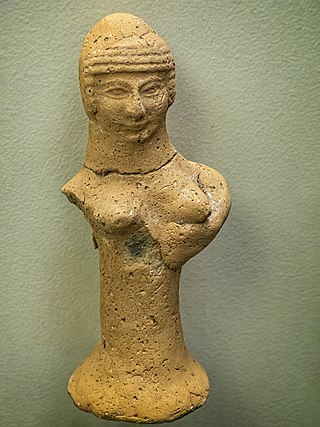
Judean pillar figures or figurines were ubiquitous household items in the Iron Age representing the Canaanite great goddess Asherah.
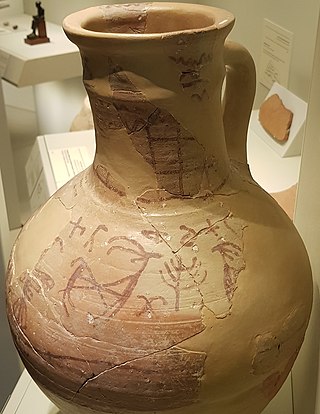
The Lachish ewer is an ancient jug discovered at Tell el-Duweir dating from the late 13th century BC, identified as the site of the ancient city of Lachish, one of the most important cities in the Kingdom of Judah.




















